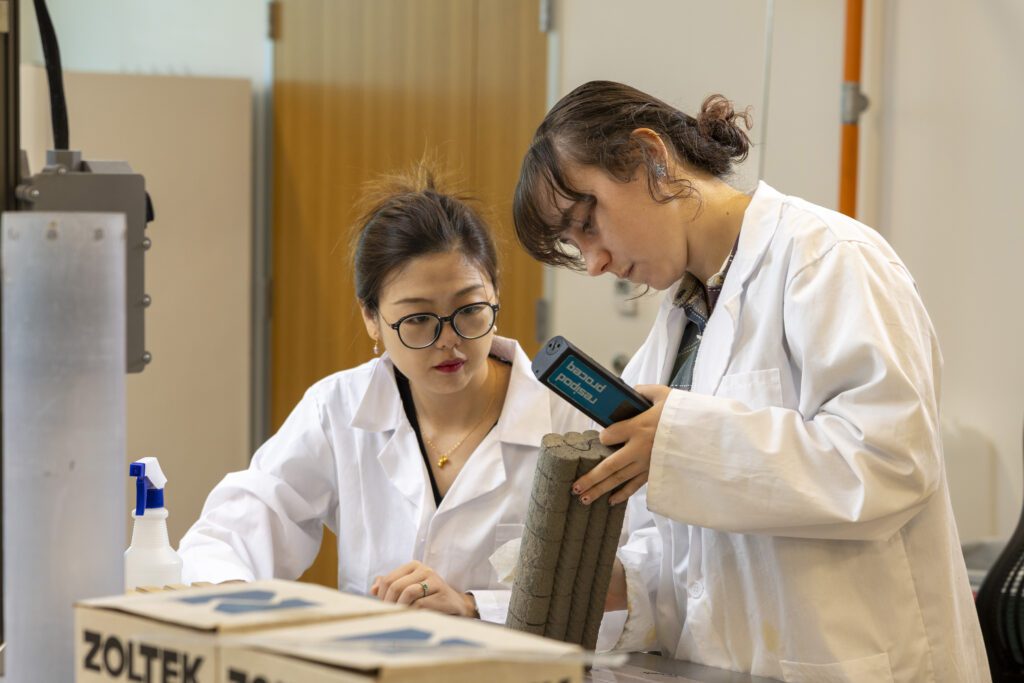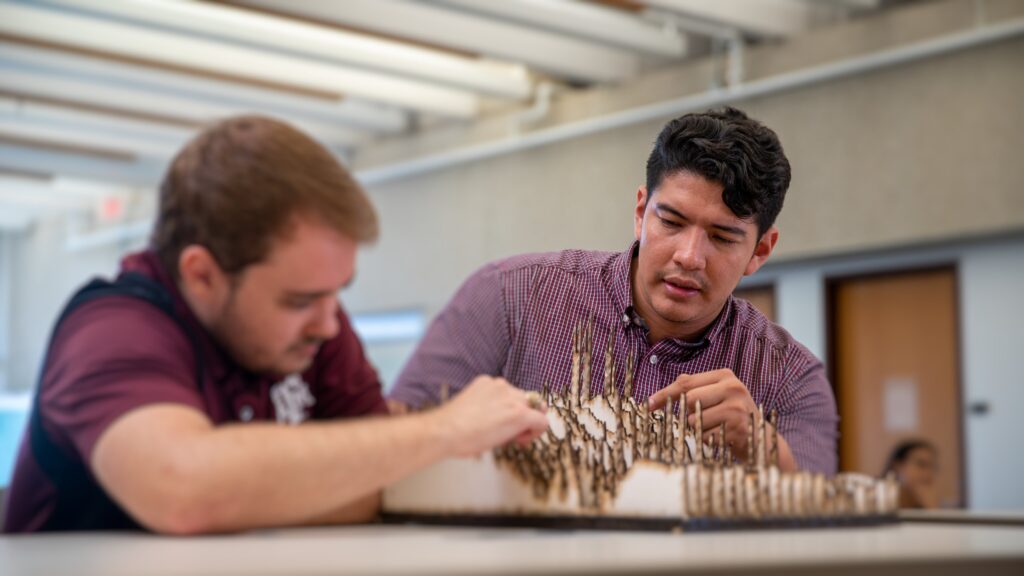After completing his bachelor’s degree in Urban and Regional Planning, Faith Jacob sought to do more. Whilst seeking solutions to Nigeria’s critical housing crisis, he found the research of Professor Shannon Van Zandt and Professor Walter Gillis Peacock at Texas A&M University about housing affordability and community resilience.
“What attracted me to the Master of Urban Planning at the College of Architecture was its outstanding reputation in planning research and its faculty of experienced lecturers,” says Jacob. “This programme aligned perfectly with my career goals at the time, which focused on finding solutions to housing and community development challenges; one of the major planning issues in Nigeria.”
As he progressed through the two-year programme, his interests expanded. He saw greater global planning challenges and a possible future for him to be a force for good in this field. “The programme has profoundly shaped my professional path by refining my career aspirations from a broad interest in community development to a specialised focus on infrastructure resilience in the face of climate change,” he says.
Today, Jacob works as a Planner in the Office of the County Engineer for Harris County, one of the largest counties in the US and a regional leader that delivers integrated professional services to diverse clients.

The College of Architecture provides world-class education across diverse disciplines, preparing graduates to lead and address complex challenges in the built environment. Source: College of Architecture, Texas A&M University
Like Jacob, many students at the college use their time there to explore different paths, uncover their strengths, and home in on the areas that truly inspire them. Another graduate, Angela Consuelo, completed both her undergraduate degree and Master of Architecture at Texas A&M. She now works as a technical designer at Page, a firm recognised for its performance-based design approach. “The master’s programme opens the door for specialisation into architecture, which was a pleasant surprise upon beginning my grad school journey,” she says.
Consuelo recalls designing a student health centre during her programme, a project that sparked her interest in healthcare design. “I would have never thought to enter into healthcare design if not for the exposure provided by this programme,” she says.
Stories like Jacob’s and Consuelo’s highlight the opportunities students in Texas A&M’s College of Architecture have that enables them to earn knowledge that lead to successful career outcomes.
Founded in 1906, the college has become a leader in architectural education, offering programmes in architecture, landscape architecture, land development, urban planning and construction science. It combines a close, supportive community with the resources of one of the nation’s largest colleges dedicated to the built environment, a field that focuses on architecture and everything humans have constructed around us that shape how we live, move, and interact every day. Campus is home to makerspaces equipped with a woodshop, large-scale fabrication site, and a cutting-edge 3D printing lab.
Industry Advisory Councils further connect students to the profession through lectures, internships, and career fairs with more than 400 firms combined, while also advising departments to ensure the curriculum stays relevant to industry needs. Having industry links complements another emphasis at the college: evidence-based design, which encourages students to back their decisions with research and data.
The impact of this approach becomes clear when hearing from Master of Landscape Architecture graduates like Trevor Deines. “The MLA programme’s focus on evidence-based design prepared me well for my professional responsibilities,” says the landscape designer at BGE, Inc., one of the top 500 design firms in the country. “As a professional, whether I am preparing a quick feasibility study for a prospective client or conducting an in-depth site analysis, I am always looking for evidence to support the design.”

The College of Architecture uses evidence-based design to create better places, offering comprehensive education in site development, planning, design, and construction to prepare learners for today’s biggest challenges. Source: College of Architecture, Texas A&M University
That mindset has shaped the career of graduates like Windya Welideniya, a Master of Urban Planning graduate who now works in local government. Her role involves projects in growth management, infrastructure planning, and equity in urban development. “The programme shaped my career by giving me both the academic foundation and the applied experiences I needed to enter the planning profession with confidence,” she says. “It sharpened my focus on transportation planning, affordable housing, and equity in community development, while also preparing me to navigate the realities of public-sector planning work.”
Internships and assistantships played a central role in Welideniya’s success. As a Graduate Assistant under Dr. Ivis Garcia, she gained research experience. Her internships with the City of Bryan, Texas, and Canete-Medina Consulting Group in Chicago further exposed her to housing, economic development, climate resilience and transportation projects. The programme also connected her to networks through Planning Programme Advisory Council (PLAN PAC) and American Planning Association (APA) conferences, where volunteering and mentorship helped paved the way for her current role as a Planner II at Lafayette Consolidated Government.
This spirit of proactive engagement is contagious. Every year, Landscape Architecture & Urban Planning (LAUP) students themselves plan and host events, such as LAUP’s Career Fair and Aggie Workshop. “Not only are the career fair and Aggie Workshop attended by some of the most well-respected firms in the field, but professionals are regularly in the architecture buildings for American Society of Landscape Architects (ASLA) meetings, Planning Accreditation Board (PAB) events, and as guest lecturers,” Deines says. “I first met my current employer when he guest lectured for one of my classes.”
Taking professional preparation even further, the college runs the only Integrated Path to Architectural Licensure (IPAL) programmes in the state of Texas. Students may choose to pursue becoming licensed professional architects while completing their studies. Emma Johnson, a Master of Architecture graduate, embraced this path wholeheartedly. “When I started the programme, my biggest goal was to become licensed, and earning my master’s degree was the next step on that journey,” she says. “Thanks to the IPAL programme, I was able to graduate not just with a degree, but also with my license in hand.”
For former US Army Corps engineer Kyle Foley, his MS in Construction Management has taken him far. Whilst feeling stuck in his previous role, he had met Interim Dean of Architecture, Dr. Patrick Suermann, at a Society of American Military Engineers (SAME) conference, who spoke about his research focused on constructing a lunar base with NASA. After a few follow-up meetings, Foley seized the chance to be his research assistant in College Station.
“As the dean’s research assistant there were a lot of opportunities for me to travel and attend conferences to inform him of what projects and opportunities were out there for Texas A&M to participate in. I built a strong network of industry, government, and academic professionals in the construction and space industries,” he says. “Ultimately these relationships led to a shift in my career path as I left my civil engineering job after graduating to work for the United States Space Force as a Lead Systems Engineer.”
Learn more about Texas A&M University’s College of Architecture.
Follow Texas A&M University’s College of Architecture on LinkedIn, Facebook, Instagram, and YouTube












